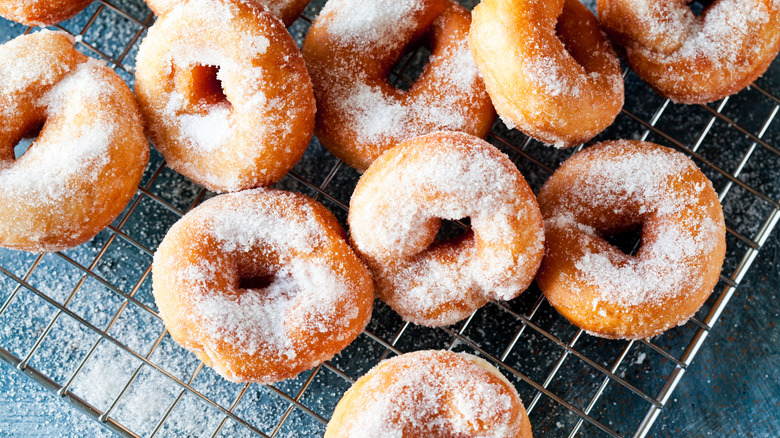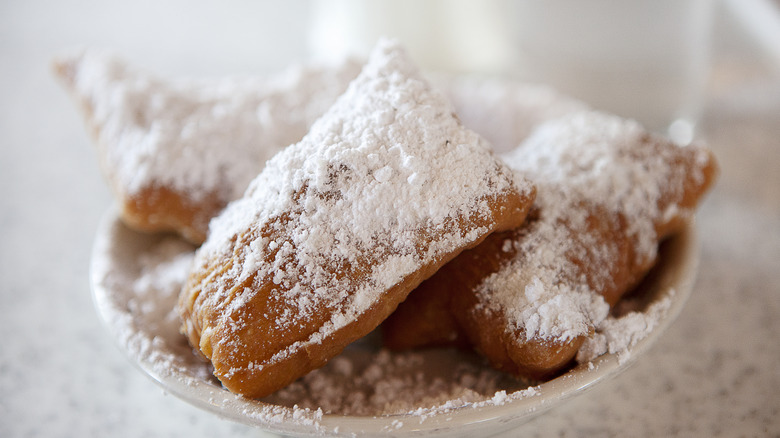Beignets Vs Donuts: What's The Actual Difference?
There's just something about fried dough that makes for some of the most irresistible desserts, no matter the form it takes. Deep fried, on a stick, smothered in chocolate, filled with cream ... the opportunities are endless. Yet not all doughy treats are created equal and are not to be confused with one another, particularly beignets and donuts. But what's the difference between these two iconic desserts? Is there really that much that separates them? The answer is a surprising "yes."
Although they may appear to be in the same family of pastries, beignets and donuts differ in a few key qualities: ingredients, rising time, appearance, and signature serving style. Donuts tend to be the denser alternative to beignets — not to mention they can be alternatively made with a cake batter as well — and are known to be significantly more versatile and elaborate. Meanwhile beignets seem to thrive off simplicity, with their classic square shape and sugary topping. Not to mention one has French origins while the other is an American staple. Both desserts are great options for serving large crowds as they can be cranked out relatively quickly and customized to your guests liking. But, you can't serve them without knowing their differences, so pay close attention to what separates these classically sweet, fried desserts.
What is a beignet?
Coming from the French word that translates to "bump," beignets are square-cut dough pillows that are traditionally deep fried and smothered in powdered sugar. Their batter consists of dry active yeast, wet ingredients like evaporated milk, and a whopping 7 cups of bread flour. Note the bread flour is important for helping the yeast rise and maintain the puffy texture of the beignets when fried. Not to be confused with the similar-tasting Italian zeppole, beignet's yeast dough only needs to rise once before being thrown straight into the frier to then be served almost immediately for that hot and ready taste.
For most people, beignets are synonymous with being the quintessential dessert of New Orleans. Thanks to the city's historic Cafe Du Monde which serves delicious beignets and coffee for an affordable price, visitors have come to praise New Orleans for this particular dessert. Their light and airy consistency mixed with the simplicity of the confectioners sugar makes them the perfect little bite of culture and cuisine. Cafe Du Monde serves beignets the original way, and the original way only, so you can enjoy them without worrying about which toppings or fillings would make for the best treat. And the truth is, most beignet recipes keep to the traditional dough recipe, only occasionally opting for something like a chocolate dipping sauce or festive sprinkle of candy cane bits. Otherwise, beignets are a great option for purists who love the taste of sweet fried dough without the extra drama.
What is a donut?
Unlike beignets which are particularly famous in a specific area, donuts are a nationwide phenomenon that have taken the dessert (and breakfast) world by storm. There are shops all over that layer donuts with fillings and special drizzles that push the envelope of what a fried dessert can be. Similar to beignets, donuts are made with a yeast-based dough but rely on different wet ingredients like warm water and regular milk; and of course you can't really have a donut without the iconic hole-punched round shape. An important aspect unique to the donut process is that they need to rise twice: once before and once after they're cut into their shape. This allows for fewer air pockets in the gluten structure, which is actually a feature of the denser-textured donuts.
While it's possible to make a simple donut glaze with just three ingredients, there is much more to be added to these desserts. Beignets keep it simple where donuts absolutely do not, and half of the fun is using the donut's shape to create decorations. You can fill the holes with candy or other treats to create special effects, or use the dessert's circular form as the base for turning the pastries into animals or holiday characters. Donuts are typically eaten when cooled so they maintain their structure better, meaning you can load up on heavy frosting and chocolate googley eyes without the dessert crumbling. So for those who love to pile on the sweets, donuts will win over beignets every time.



